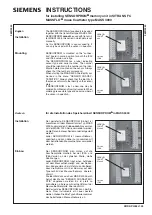
Chapter 18. Global Copy options and configuration
211
The steps in the procedure shown in Figure 18-3 are the following:
1. Quiesce the application updates.
2. Synchronize the volume pairs by one of these methods:
– Perform the catch-up by doing a
go-to-sync
operation
. This can be done with the
Storage Manager as shown in 18.2.3, “Go-to-sync using the DS Storage Manager” on
page 208. The volume pair leaves the copy pending state and reaches the full duplex
state. At this time, if the pairs were not immediately suspended, primary write updates
would be synchronously transmitted to the recovery site.
– Perform the catch-up by waiting until all application updates are transferred to the
secondary site.
You can monitor the number of out-of-sync tracks with the DS Storage Manager or with the
DS CLI as shown in 18.2.5, “Display out-of-sync tracks” on page 209.
3. Suspend the Global Copy pairs after they reach the full duplex state. If you use
Consistency Groups, issue do a freeze operation.
At this point, we have a set of consistent secondary volumes.
4. You can resume the application. Updates are not copied to the secondary volumes
because the pairs are suspended. The secondary volumes remain consistent, and the
application does not experience any response time impact.
5. Perform a FlashCopy on the secondary volumes.
6. Resume Global Copy mode for the copy pair.
For applications recovery based on point-in-time copies, you must plan for appropriate
checkpoints to briefly quiesce the application and synchronize the volumes pairs. When the
recovery of the application is done, you must remember that, while in an active Global Copy
relationship, the secondary volumes always have a current fuzzy copy of the primary
volumes, so you have to keep the tertiary volumes where you did a FlashCopy of the last
globally consistent catch-up. Therefore, this tertiary copy does not reflect the current update,
but rather any updates up until the last global catch-up operation.
18.4 Cascading for ESS migration
Asynchronous cascading PPRC is a function of the IBM TotalStorage Enterprise Storage
Server (ESS), where the secondary volume of a Global Copy or Metro Mirror volume pair
becomes the primary volume of another Global Copy or Metro Mirror relationship. Cascading
allows you to set a remote copy relationship from a source volume through an intermediate
volume to a target volume.
The two volume pairs in a cascaded relationship can be either Global Copy or Metro Mirror
pairs with one exception: the first pair (source to intermediate) cannot be Global Copy if the
second pair (intermediate to target) is Metro Mirror. The two pairs can be established in any
order; that is, first and second here do not refer to the order of establishment.
Cascading can be useful when you are migrating data from an ESS to the DS6000. If the
volumes to be migrated are mirrored between two ESSs with Metro Mirror, you can set up a
cascaded Global Copy from the secondary ESS to the DS6000. Then, you can migrate the
volumes without having to delete the existing volume pairs.
Cascading can also be used if you need to migrate data from an ESS Model F20 to a
DS6000. This cannot be done directly with Global Copy because the ESS F20 only supports
ESCON remote copy links, while the DS6000 only supports FCP links. The migration can be
Summary of Contents for System storage DS6000 Series
Page 2: ......
Page 24: ...xxii IBM System Storage DS6000 Series Copy Services with IBM System z...
Page 38: ...14 IBM System Storage DS6000 Series Copy Services with IBM System z...
Page 40: ...16 IBM System Storage DS6000 Series Copy Services with IBM System z...
Page 60: ...36 IBM System Storage DS6000 Series Copy Services with IBM System z...
Page 64: ...40 IBM System Storage DS6000 Series Copy Services with IBM System z...
Page 66: ...42 IBM System Storage DS6000 Series Copy Services with IBM System z...
Page 86: ...62 IBM System Storage DS6000 Series Copy Services with IBM System z...
Page 92: ...68 IBM System Storage DS6000 Series Copy Services with IBM System z...
Page 144: ...120 IBM System Storage DS6000 Series Copy Services with IBM System z...
Page 152: ...128 IBM System Storage DS6000 Series Copy Services with IBM System z...
Page 204: ...180 IBM System Storage DS6000 Series Copy Services with IBM System z...
Page 208: ...184 IBM System Storage DS6000 Series Copy Services with IBM System z...
Page 224: ...200 IBM System Storage DS6000 Series Copy Services with IBM System z...
Page 242: ...218 IBM System Storage DS6000 Series Copy Services with IBM System z...
Page 260: ...236 IBM System Storage DS6000 Series Copy Services with IBM System z...
Page 288: ...264 IBM System Storage DS6000 Series Copy Services with IBM System z...
Page 290: ...266 IBM System Storage DS6000 Series Copy Services with IBM System z...
Page 358: ...334 IBM System Storage DS6000 Series Copy Services with IBM System z...
Page 432: ...408 IBM System Storage DS6000 Series Copy Services with IBM System z...
Page 434: ...410 IBM System Storage DS6000 Series Copy Services with IBM System z...
Page 438: ...414 IBM System Storage DS6000 Series Copy Services with IBM System z...
Page 454: ...430 IBM System Storage DS6000 Series Copy Services with IBM System z...
Page 456: ...432 IBM System Storage DS6000 Series Copy Services with IBM System z...
Page 480: ...456 IBM System Storage DS6000 Series Copy Services with IBM System z...
Page 490: ...466 IBM System Storage DS6000 Series Copy Services with IBM System z...
Page 524: ...500 IBM System Storage DS6000 Series Copy Services with IBM System z...
Page 552: ...528 IBM System Storage DS6000 Series Copy Services with IBM System z...
Page 560: ...536 IBM System Storage DS6000 Series Copy Services with IBM System z...
Page 564: ...540 IBM System Storage DS6000 Series Copy Services with IBM System z...
Page 574: ...550 IBM System Storage DS6000 Series Copy Services with IBM System z...
Page 577: ......
















































